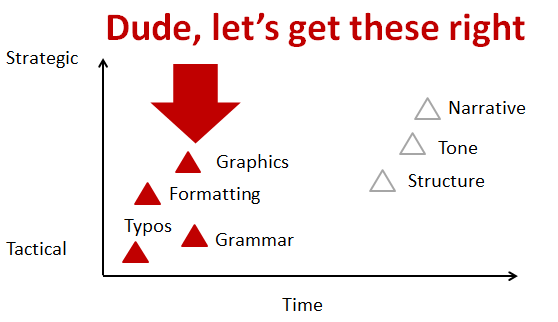“You have a typo on the 1st page”
This was the low-light of my Friday. A partner was reviewing a proposal we had already printed out for the client. One typo was a missing helping verb “be” and the other typo was a verb in the wrong tense. It was a bad verb day. Some might find this a trivial matter, but this is sloppy and poor quality. Where is the proof reading?
The proposal was good
My buddy and I spent 2 late nights on the proposal. A lot of things I liked about the document:
- It had a distinct point of view, differentiated; it stood for something
- Strong narrative; telling the story of how we would help them
- Sharp visuals with clear examples of the work we do
- The pricing was reasonable, a good value; hell, I would have paid for it
It was proof-read (kind of)
The tragedy of course was that I had the file proof-read by two people . . .two people, and both typos were not caught. Why didn’t they catch it? Seriously? Perhaps I could have been more prescriptive, perhaps I was too casual. It is my fault (take more blame, give away more credit is how managers need to operate).
Small (even superficial) things matter
Clients pay consultants to give them advice, dig through ugly data, clear through the politics, and do great work. They don’t want to see the ugly reality that we are pretty human, full of flaws, and sometimes slackers.
What is good proofreading?
This takes many different levels, ranging from the strategic to the tactical, depending largely on how much time there is to the due date. If you have 15 minutes to proof read, you will only be looking for the most obvious errors. If you have 2 hours, and the author has 3 days to improve it for another round of proof-reading, then you can look at some of the more structural and strategic issues too.
Each of these “levels” of proof-reading should ideally be done separately. . . so that you read once for strategic / narrative / structural feedback. Then you read for tactical / grammar / typo / usage. Try to proof 2-3 times, before you send back to the author.

Strategic / Structural:
- Narrative: Section headers (e.g., Introduction, Approach, Timeline) in a logical order, clearly describing the content. Anything missing?
- Thesis-statement: Each paragraph has a point; it’s easy for the audience to follow the logic
- Style: Good writing is direct. Take out superfluous, flowery, or deliberately vague consulting-y language. For a list of cheesy consulting words look here.
Tactical / Superficial:
- Spelling: Spellcheck only catches obvious things. It does not catch “auto-corrected” phrases and abbreviations
- Grammar: This is the stuff we miss late at night when writing late at night (its/it’s) (they’re/their/there) (compliment/complement); list of common mistakes here
- Parallel Structure: When you make bullet-ed lists, make sure they all start the same way (if verbs, then use verbs), (if nouns, use nouns)
Visual:
- Graphs / Graphics: Visuals should be clean, clear, and relevant. I am a hater (strong word I know) of clip art / photos / filler graphics.
- Formatting: Everything should be consistent. Use the same font, font size on each section. Use the same bullets and alignment. Add page numbers. Be mindful of page breaks, and print settings (the worst is excel not formatted for printing)
- Tables: Alignment within the cells (top/middle/bottom), column and row spacing, wrap text so it’s visible

Lesson Learned:
- Need to be more specific to proof readers. . .(hey, could you check for #1 flow #2 typos, syntax, usage, and language?)
- Need to do the final proof read myself. . . reading it out-loud
- Need to start earlier, give myself more time to work on it (not under pressure)
- Need to find better proof-readers
Will let you all know if we win the proposal. If we win – it was not because of the 2 typos. If we lose – it was not because of the 2 typos. Let’s get real.

You have a typo in your 2nd sentence. You are missing a “the” before client.
Love it.
Good article. Infact there is a hidden problem with the typo mistakes. When we use language converters, the mistaken part may create a reverse scenario. In the converted language, the meaning may be just opposite of what we intended.
So true. I think one-third of my readers are from countries where English is not the first language. Great point.
Great points in this post. I have a team of consultants who have come up quickly in their careers and are always striving for the next big thing. However, I constantly reinforce the fundamentals with them, as faltering on those can marginalize and jeopardize an entire deal or deliverable. In fact, when I first started in my career, the CEO of my boutique consultancy reviewed a 100+ slide deck that I built and picked out seven typos. He sat me down, looked me in the eye and said, “Greg, if I didn’t know any better, I would think that you don’t give a sh*t about your work, this company, or, most importantly, our clients.” A decade later…it still resonates.
Thanks for the continued content – we get a ton of value!
Awesome. Great story. Reminds me of the saying. . . “Good judgment comes from experience. Experience comes from bad judgment.”
Amen